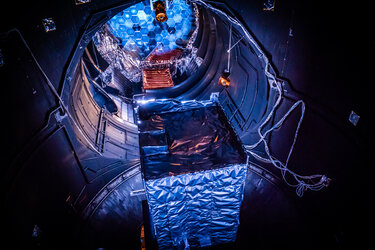Smoking cold
A major challenge of testing technologies and materials for space is that the orbital environment can be both very hot and extremely cold at the same time – this latter factor explaining why ESA researchers go through large volumes of liquid nitrogen.
Fracture Engineer Andreas Tesch is seen filling a vacuum flask with liquid nitrogen in ESA’s Materials and Electrical Components Laboratories, based at the ESTEC technical centre in Noordwijk, the Netherlands. Liquid nitrogen having a boiling point of just –196°C, the mandatory safety gear to handle it includes protective gloves, goggles and boots.
In the absence of any moderating atmosphere, satellite structures might simultaneously experience 150°C heating on sunlit surfaces while plunging to a –150°C chill in adjacent shadow.
In ground laboratories, lamps and heaters simulate sunlight while cryogenic refrigerants such as liquid nitrogen reproduce the deep cold of space in the shade, supplemented when necessary by mechanical cooling.
Key tests include frequent ‘thermal cycling’ between temperature extremes, as well as mechanical, fracture mechanical and fatigue testing. Samples may also be exposed to ultraviolet radiation or the erosive atomic oxygen prevailing in low orbits at the same time.
Liquid nitrogen is also useful for thermal analysis – checking the heat transfer rate of candidate materials – or simply to ‘freeze’ test items in a particular condition for subsequent analysis.
Current projects being supported through tests of this kind include ESA’s BepiColombo mission to Mercury, the ExoMars lander and the James Webb Space Telescope, as well as candidate parts and materials for future space missions in general.
While ESTEC’s labs concentrate on putting parts, materials or subsystems to the test, the adjacent Test Centre evaluates entire satellites in thermal vacuum tests that might last for weeks on end, requiring multiple tanker lorries to call daily to replenish the liquid nitrogen.






